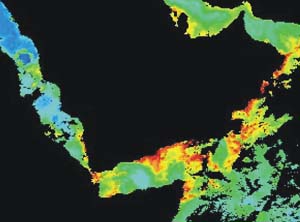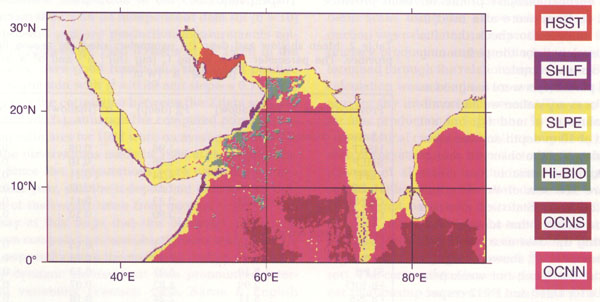|
|
Staff involved:Dr Rob Upstill-Goddard, Prof Nick Owens, Mr Jon BarnesFunding:Natural Environment Research Council
SeaWiFS chlorophyll-a map for the north-west Indian Ocean in August 1998 showing upwelling off Yemen, Oman and Somalia associated with high phytoplankton production |
Emissions of greenhouse gases (N2O and CH4) from the Arabian Sea and NW Indian OceanProjectThe Arabian Sea/northwestern Indian Ocean (NWIO) comprises an unique variety of biogeochemical provinces, including eutrophic, oligotrophic, upwelling, and oxygen-depleted zones, all within an area of relatively small geographic extent. This variety of environments reflects the pronounced semi-annual reversals in regional winds (the seasonal monsoons) that make this region a focus for intense study. The wind systems trigger a strong upper ocean response, one consequence of which is the upwelling of nutrients and biogas-rich deep waters, that stimulates primary productivity and enhances the potential for sea-air biogas transfer. Large N2O supersaturations in the upwelled waters originate from coupled nitrification/denitrification in deep waters of the oxygen-depleted zone (ODZ). Correspondingly high CH4 supersaturations are most likely associated with enhanced primary productivity in the mixed layer. Previously published sea-air flux estimates indicate that the NWIO could account for 12-52% and 0.1-133% respectively of the known oceanic sources of N2O and CH4. Even though the uncertainties are large, particularly for CH4, the Arabian Sea/NWIO could be an important contributor to the marine CH4 source and a dominant global source of atmospheric N2O. We obtained 75 detailed oceanographic profiles for N2O and CH4 in the Gulf of Oman and the northern and central Arabian Sea during two cruises of RRS Discovery, in the latter stages of the SW monsoon and subsequent intermonsoon transition of 1994. This work was an integral component of "Arabesque", a UK contribution to the Joint Global Ocean Flux Study (JGOFS) in the Indian Ocean.
SignificanceThe atmospheric inventories of N2O and CH4 are currently both increasing by about 0.3 % per year. Both gases are strongly infrared active, together accounting for 18% of enhanced greenhouse forcing. N2O is implicated in the generation of stratospheric NOx, which influences stratospheric O3 levels, and CH4 participates in the photochemistry of tropospheric O3 and OH and in the formation of stratospheric H2O. Existing estimates of oceanic N2O and CH4 sources are dominated by disproportionately large contributions from biologically productive areas such as the NWIO. However, because the spatial and temporal coverage of such regions remains limited, our global estimates remain unsatisfactory. Future climatically induced modifications to the upwelling and circulation characteristics of the NWIO and other regions experiencing strong wind-driven upwelling may have profound effects on future biogas emissions from the oceans. Refinements to our understanding of these important ocean regions should be a key aim. Future directionsWe will participate in a new multi-institutional NERC-funded initiative involving a research cruise in the NWIO during summer 2002. The overall aim is to determine the transport and fate of upwelling water filaments and their contribution to primary production, export and biogenic gas inventories during the SW Monsoon. Upwelling filaments will be tracked with a Lagrangian tracer (SF6) to follow their evolution and the offshore export of nutrients and carbon. We will examine the fate of upwelled nutrients involved in phytoplankton speciation and succession and evaluate the production and air-sea flux of trace biogases including N2O, CH4, CO2, DMS, halocarbons and methylamines. Budgets will be constrained within the Lagrangian framework with coincident parameterisation of air-sea exchange rates by dual tracer release (SF6 and 3He). The offshore filament transport and associated gradients in productivity, phytoplankton speciation, and biogenic gas distributions will be related to remotely sensed ocean colour and temperature, in order to develop and refine predictive algorithms. References
|

 Areas occupied by the 6 biogeochemical provinces identified in Watts et al. (1999) for the north-west
Indian Ocean basin, for the monsoon month of September
Areas occupied by the 6 biogeochemical provinces identified in Watts et al. (1999) for the north-west
Indian Ocean basin, for the monsoon month of September